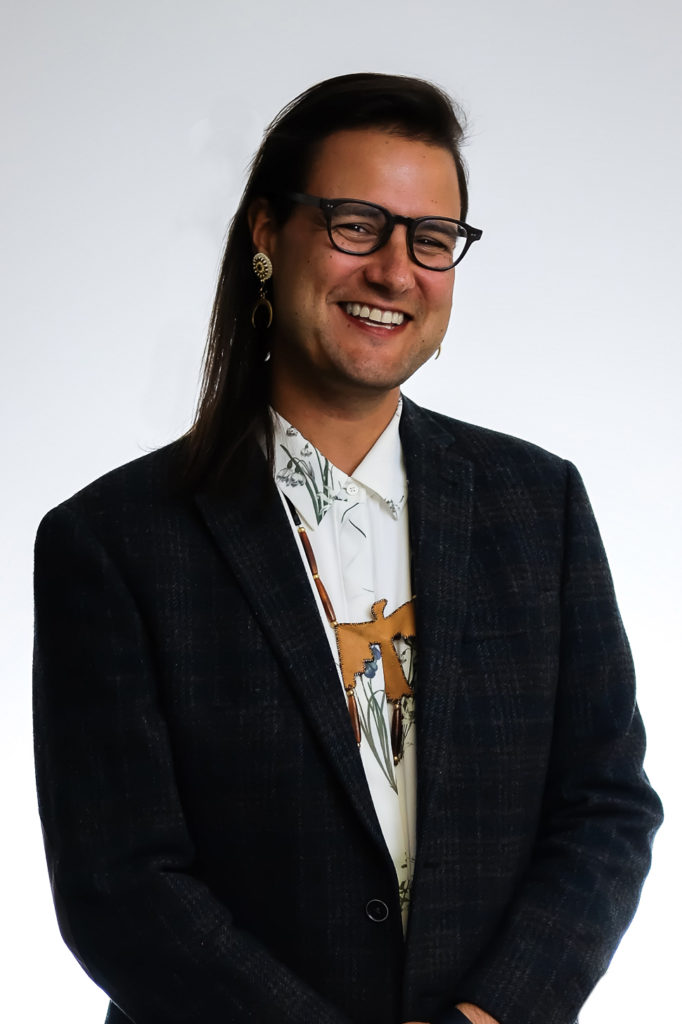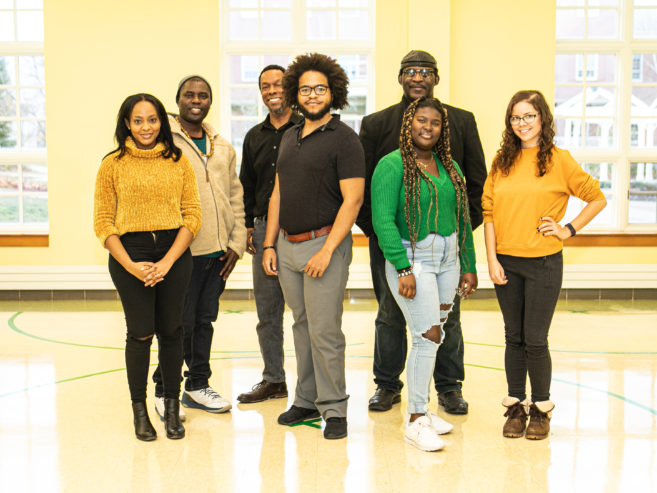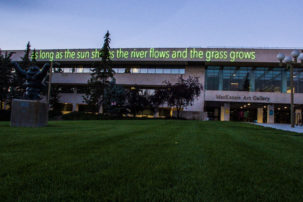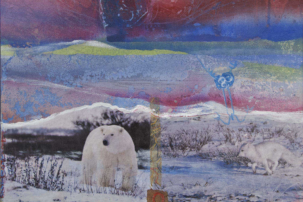On June 24, John G. Hampton was appointed interim executive director and CEO of the Mackenzie Art Gallery in Regina. Hampton is currently director of programs there, and the appointment is effective August 1.
It’s a significant move on many fronts. Hampton joined the gallery in 2018 as the first Indigenous (Chickasaw) leader of both curatorial and education programs at a major Canadian art institution. Soon, he will be the first Indigenous executive director and CEO of such an institution as well, even on an interim basis.
Recently, Hampton took some time to speak with Canadian Art about his new role, and his hopes for it—as well as his team’s recently released in-progress public research for “Conceptions of White,” a forthcoming exhibition on the “origins, development, and present reality of ‘whiteness’ as a concept.”
LS: You are the new interim director of the Mackenzie Art Gallery. What are your goals right now in terms of what you hope happens during your tenure in that role?
JGH: Well, the goals at this point are both very clear and very ambiguous. It’s a terrible and an exciting time to be stepping into a leadership role in a cultural institution. We’re at a strange point as a society right now, and how cultural organizations situate themselves within that is, I think, being disrupted to a very large degree.
We’re a short while away from reopening our doors to the public, and to a changed relationship with the public. There will be a lot of people who will be coming through our doors after experiencing—for the first time, in a way—what it is like to feel unsafe in public spaces. Some are also recognizing that many others never truly felt safe in public spaces previously. Those two things coupled together, puts us in a position where we really need to rethink both our relationship to our audiences and communities and what our role and responsibility is there. I don’t know if there’s any way to move forward other than trying to take a trauma-informed approach towards rebuilding these relationships from a perspective of safety, of trust, of relationality—creating spaces to process, to relate and to think through what the culture we want to build into the future looks like.
That’s one of the largest overarching goals we are currently facing. In March, we struck our COVID task force and made some very rapid changes to the institution and our activities. Following that, and the global uprisings against racist systems of oppression—of which the museum is a component—Anthony Kiendl (the current CEO) and I decided to take what we learned from the COVID task force and apply the same kind of urgency to an equity task force. The two of us, as outgoing and incoming CEOs, are working on that right now, to try to address and articulate systems of violence in our society and institutions in a much more urgent manner. So that is our top priority over this transition period: how to set in place some early actions, as well a pathway to address these issues more rapidly than we have in the past.
I genuinely believe the Mackenzie is doing well in relation to the benchmark of other cultural institutions—but you know, when the starting line is cultural genocide, even making a lot of progress still leaves a lot of room to go.
LS: “Conceptions of White” is a project the Mackenzie recently made public and that you will be working on with Lillian O’Brien Davis and Barbara Fischer during your interim director term. Can you tell me more about this project and how you hope it develops during your time as director?
JGH: This exhibition is one that I’d been working on before coming to the Mackenzie—with Barbara for the Art Museum at the University of Toronto—and I spoke about it in my interview (for director of programs) as an example of the type of project I wanted bring to the gallery. And really, it’s just disappointing to see the urgency of it only continue to increase since then.
For me, it’s something that I’ve been thinking about for a long time: trying to understand what the origin and meaning of whiteness is, and how it has shaped the society that surrounds me, how it has impacted that, and how it manifests itself within myself, as well—as a Chickasaw citizen, but also someone that has greatly benefitted from and has been embedded within systems of whiteness. In 2018, I had a chance to talk to Lillian O’Brien Davis about her thesis work, which dealt with very similar issues and research, although she was looking at biracial Black experience while I was approaching the intersection of white and Indigenous identity. So after Lillian joined the curatorial team at the MacKenzie, the project actually began to take shape.
I spend a lot of time thinking through Indigeneity—how we code and legislate that identity in North America, and what it means to be an Indigenous person. But scholarship is not quite as developed around the history and invention of the white race. There’s all the incredible violence that it perpetrates against Black and Indigenous people and other people of colour, and [there’s violence] also against the cultural identity of the people who are reclassified as white. There is a requirement to almost erase one’s cultural history, if you think of the United States putting people into a “melting pot.”
That “melting pot” construct created one of the best definitions of whiteness I’ve come across—taking the cultural difference of many diverse peoples and melting them into one unified people, which was white—historically this was exclusively western European, and has expanded from there.
LS: By happenstance only, I saw the exhibition “White: Whiteness and Race in Contemporary Art” at the International Centre for Photography in New York in 2005. But as a nonacademic, I must admit, I haven’t seen many art exhibitions explicitly on whiteness happen since then. I’m glad this project is happening at the Mackenzie.
JGH: There have been a handful of exhibitions on whiteness, but it is really underexplored. This is the first time that I have publicly shared in-progress research like this, and I don’t think it’s too common of an activity—but it’s been quite rewarding from a number of perspectives. For one, several people have reached out with extra readings, or artists that are working on things, and it’s just really given a huge shot of adrenaline into the project to invigorate it and keep that momentum going.
But also, an exhibition can’t include the majority of your early ideas and interests. With so many shows, you do all of this background research and try to get a good, strong understanding of concepts in the field that you are working with. But an exhibition is not a research paper—and it’s not really authored just by the curators. When the artworks come together and you start to put those into an exhibition, they form around a discourse of their own, and you’ve got to put a lot of the research aside to allow the exhibition to find a focus.
There are so many bizarre characteristics and idiosyncratic elements of these histories and configurations of whiteness; this material can’t be covered in one single show. There will be, I think, room and need to explore it much more widely as well; we just wanted [with the recent announcement] to put a bit of what we’ve been looking at out there—a lot of which won’t be visible in the eventual exhibition.
LS: Is there anything else you want people to know right now about your new role or hopes for it? Some folks are quite excited that you, with your Indigenous experience and presence, will be leading the gallery. Any thoughts on those expectations for this role?
JGH: It was very sweet, seeing the impromptu press release that Camille Usher at the Aboriginal Curatorial Collective put together. It’s really humbling, an incredible honour and also an incredible responsibility to see that type of community outpouring and support.
It’s beautiful to have that support network and the strength of that backing to help do the work that I need to do. But it’s not for me as an individual—it’s for the needs of our community and the needs of our institutions.
There have been several times over the past week where I have been struck by how precarious our positions are in life, and how much luck is involved. Before joining the MacKenzie, I consulted with the Canadian Art Museum Directors Organization’s diversity and decolonization committee; that space is where I first started working with Anthony Kiendl to try to think through the enormity of the task of trying to change the demographic make-up in the leadership of our institutions; how to set up new voices for success, and the limitations we have with current institutional and societal configurations.
I am only just arriving at a place where I feel equipped to lead this institution in an interim capacity, and the part of that is because Anthony created my previous position and set up this path for succession. That continues a long line of fortunate circumstances, mentors and helping hands. I feel like many of these helping hands wouldn’t have been there if I was starting out even a few years earlier. It was extremely important for me to have professors/mentors like Carmen Robertson, Rachelle Viader Knowles, Randal Rogers, David Garneau, Elder Betty McKenna, Barbara Fischer, and many more; to have Indigenous officers like Jim Logan at the Canada Council; the Aboriginal Curatorial Collective with the life changing connections I made there; all the white folx trying to reorient institutions away from reifying their own positionality; and all the bad ass Indigenous, Black and POC folx and role models that have been kicking down doors and calling out bullshit in a way that I’m too soft spoken to do myself.
Part of being interrelated within our communities is feeling simultaneous joy and pain resonating from different parts of your network, and trying to stay attuned to what role you can play in undertaking the work that needs to be done for the health and growth of the all your relations. I just hope that I can do that work in a good way, and do my community members proud.

 John G. Hampton.
John G. Hampton.





